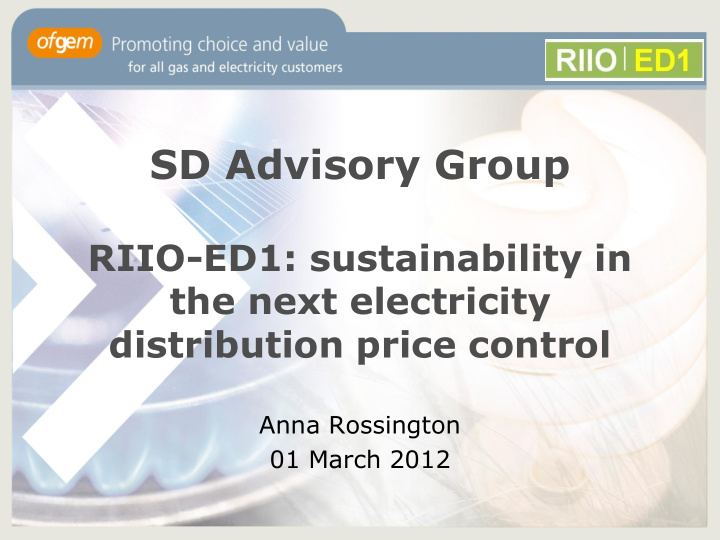



SD Advisory Group RIIO-ED1: sustainability in the next electricity distribution price control Anna Rossington 01 March 2012
RIIO-ED1 launched Initial Initial Strategy Business plans Fast track Proposals: Decision: March consultation: submitted: June Sept - Oct May Final Proposals: Fast track Launch consultation: Strategy Consultation Dec Feb 2012 Decision: Feb Nov 2012 2013 2014 policy development Implementation of RIIO model in electricity distribution 8 year price control: 1 April 2015 – 31 March 2023 Process will build on learning from RIIO-T1&GD1 Policies will build on DPCR5, and initiatives such as Smart Grids Forum 2
DPCR5 Current price control (DPCR5) precursor to RIIO framework: • Run in parallel to RPI-X@20 (RIIO) • Recognised need for DNOs to anticipate low carbon future • More focus on outputs • Targeted customer focussed DNOs objective DPCR5 - Reduce DNOs’ environmental impact - £500m Low Carbon Networks fund - Enable customers to adopt low - Losses incentive carbon or energy saving measures - Funding for undergrounding of lines in AONB & NPs - Ensure DNOs prepare for change in - BCF reporting network use - Reduce barriers to DSR & DG - Better information for DG connectees - DG incentive - Cost reflective charging - Broad measure of customer satisfaction - Same incentive strength on operating costs & assets 3
RIIO-ED1 Key Challenge Driving factors 2020 targets • Feed-in tariffs • RHI • Other incentive mechanisms • Local planning rules • Technological developments uncertainty around the & reductions in cost characteristics, rate and location of take-up of Facilitating factors these technologies • Investment to expand and reinforce the distribution network • Greater use of smart grid ED1 ED2 technology & DSR to maximise network flexibility at minimum cost standard asset life Issues to consider for ED1 • DNO approach to developing business plans – scenarios and investment justification • Outputs DNOs are required to deliver – longer term? • Barriers to DNOs adopting commercial arrangements to manage demand and generation output • Incentives and uncertainty mechanisms Ensure low carbon technologies can connect in appropriate time at appropriate cost 4
Environment/Social Output categories Environment • Help to minimise the environmental impact of DNO operations and of users on the network by: – ensuring low carbon technologies can connect at a reasonable cost and in a timely manner Roll-out of smart meters will uncover issues affecting – managing losses accuracy of losses data. BUT once smart meters in – minimising business carbon footprint place, accurate losses measurement – minimising material non carbon emissions – using a stakeholder based approach to visual amenity in areas of outstanding natural beauty or national parks – potentially encouraging any role the DNOs might play in Local Authorities’ integrated energy schemes. Social obligations • Priority services register obligations in licence. • Could include issues such as initiatives to target the fuel poor? 5
Discussion questions Low carbon connections • Thoughts on potential barriers and other issues • Any thoughts on how we can address? DNO environmental impact • Any other areas we should consider? • Any role for DNOs with integrated energy networks? Social • What should we consider? Objective to have a proportionate approach – targeting the material elements 6
7
Recommend
More recommend